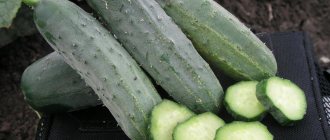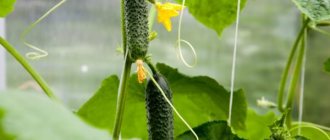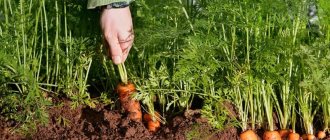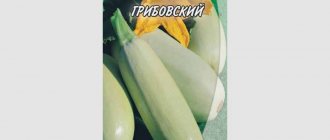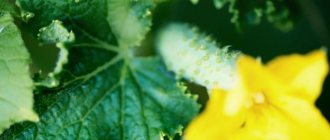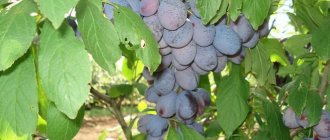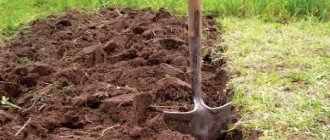It is worth starting the description of the cucumber variety Relay f1 with the fact that it is a well-known and time-tested domestic product - it was created in 1979. The cucumber is recommended for the Central, North-Western and Southern regions of Russia. This variety feels best in greenhouses. This is a late cucumber - its ripening period varies from 53 to 56 days. The use of Relay f1 is mostly in salads, but it can also be used in canned food.
Description of cucumbers Relay race f1
Cucumber Relay f1 is a prolific, shade-tolerant hybrid with good stress resistance and high immunity. Its productivity is one of the best among the “old” varieties. In greenhouse conditions, you can collect more than 40 kg/m². Main characteristics of the Relay plant:
- The bush of the variety is medium-branched, with self-regulation of the growth of lateral branches.
- The leaves are medium in size, wavy at the edges, rich green in color, the flowers are small, bright yellow.
- The cucumber itself is long - up to 20-22 cm, weighs up to 200 g, and is 4 cm in diameter. The shape of the vegetable resembles a spindle, its color is dark green, almost uniform.
- The skin of the greens is thin, but quite dense; there are rare, but large, slightly pubescent tubercles on it.
The taste of cucumber is sweet, aromatic, without bitterness. Its pulp, according to the description, is juicy, fresh, and has no voids. The f1 relay boasts excellent transportability and storage characteristics.
Possible diseases and growing problems
With proper cultivation of the soil in the greenhouse, planting material, as well as proper care, most diseases typical of cucumbers can be avoided. However, even experienced gardeners encounter the latter.
How to distinguish a disease from pest damage and the consequences of improper care? The easiest way to use the classifier is to compare damage on plants with images.
Diseases and pests of greenhouse cucumbers (part 1)
Diseases and pests of greenhouse cucumbers (part 2)
General methods for controlling diseases of cucumbers and their pests:
- if viral diseases are detected, the plants are removed from the summer cottage or burned, the greenhouse is subjected to intensive treatment;
- if affected by a fungus, the damaged parts of the plant are removed, after which they are treated with fungicides three times with an interval of 5-10 days;
- treatment with solutions of manganese, iodine, as well as copper-containing preparations helps against bacterial rot;
- sucking and gnawing pests are exterminated using systemic insecticides;
- Slugs are fought with the help of ash or eggshells scattered on the soil, as well as chemicals intended for this purpose.
Video - Diseases and pests of cucumbers: how to fight?
With the right choice of variety and proper care, cucumbers in a greenhouse give a good harvest even in cold and rainy summers. Fruiting can last until frost if preventative treatments against pests and diseases are carried out in time.
Pros and cons of the variety
The variety in question has very good yield characteristics and disease resistance. The f1 relay is generally easy to care for and can withstand harsh weather conditions. At the same time, the cucumber needs pollination by bees, which is difficult in greenhouses and requires careful work on the formation of the bush.
pros
Relay has established itself over several decades as a prolific, hardy and not capricious variety. Among the most important positive qualities of a hybrid:
- excellent yield - in a greenhouse, with decent care, judging by the description, you can grow 40-44 kg/m²;
- stress resistance - cucumber is able to withstand minor frosts and short-term drought without serious losses;
- excellent immunity - the variety has developed resistance to various rots and cucumber mosaic;
- good shelf life and transportability - Relay f1 can be stored for more than a week without losing its taste and presentation, and can also be transported over long distances without spoiling.
Cucumber has an excellent taste and a light, fresh aroma; it can harmoniously complement any summer salad and become a wonderful raw material for preservation.
Minuses
Cultivation of this variety is very profitable, but not as simple as it seems at first glance. There are several unpleasant nuances for a gardener associated with growing Relay f1:
- bee pollination - a cucumber needs pollination by bees or bumblebees, in a greenhouse for this you need to add insects manually;
- vulnerability to powdery mildew - unlike varieties such as Lastochka f1, cucumber requires preventive treatment with antibacterial drugs.
Finally, the Relay Race requires a certain sequence of actions for the correct formation of the bush so that the plants can produce the maximum yield promised in the description.
Advantages and disadvantages
Based on their description of the variety, the undoubted advantages of Relay cucumbers include:
- resistance to most diseases, in particular not susceptible to root rot and mosaic virus;
- high yield - 22 - 45 kg are harvested from 1 m;
- good transportability and keeping quality;
- excellent taste and excellent presentation;
- long, continuous fruiting;
- shade-tolerant, does not require constant lighting of the greenhouse.
The culture also has some disadvantages:
- late ripening, development period before fruiting is 53 - 66 days;
- instability to true and downy mildew;
- pollinators required;
- with limited irrigation and extreme heat, bitterness develops in the fruits.
Landing Features
This cucumber is also known for the fact that it is quite capable of ripening in a greenhouse in the autumn-winter period. However, the most fruitful time for cultivating the hybrid is late spring-early summer. The relay is not capricious regarding soil conditions, but it is better to choose nutritious and loose soil.
Landing dates
Seeds of the variety begin to be planted for seedlings in the first half of April. The main thing is to wait for the air temperature in the area to be at least 19°-20°. Sprouted sprouts of Relay f1 are transferred to protected ground from mid-May, closer to the second half of the month. The night temperature, judging by the description, should not fall below 18°.
Do not forget about good lighting - a cucumber needs a 12-hour day of light.
Soil preparation
Relay f1 is best planted in elevated areas well lit by the sun. The ideal soil for the variety is nutritious black soil, or crumbly, light sandy loam soil. Since September, it has been dug up, completely replacing the top 45-50 cm layer of soil, after which the area under the cucumber is cleared of weeds and disinfected with a solution of copper sulfate. The last stage is fertilization with urea, or mullein. 3-4 days before planting Relay, the area is loosened again, holes are cut for the variety, and chicken droppings and wood ash are placed at the bottom.
Planting seeds
Relay seeds are planted in separate containers, as their root system can be seriously damaged when transferred. Before planting, the material is disinfected in a manganese solution for 40 minutes. 3 seeds of the variety are added to each pot. During this period, the cucumber needs daily watering, fertilization with peat, humus and a growth stimulator. If there is not enough light for Relay f1 plantings, lamps are installed around the seedlings. A germinating cucumber requires a temperature of at least 17°.
Planting seedlings
The seedlings of the variety are ready for transfer to the greenhouse already on the 27-28th day after germination of the sprouts. 6-7 days before planting, they begin to harden the cucumber - they take it outside first for 15 minutes, on the second day for 20, etc. For transplantation, a sunny, but not hot, and windless day is chosen.
Relay sprouts are deepened by 5-6 cm, up to the 2nd leaf. After planting, the seedlings are watered abundantly and the soil around is loosened.
Planting scheme
Relay f1 seedlings are quite compact, but too dense planting can provoke diseases. On 1 sq/m² you can freely place 3 bushes of the variety, in open ground the number increases to 5. Cucumber requires wide row spacing - about 70-75 cm, but the distance between neighboring Relay bushes can be minimal - 30 cm. During the growth process The cucumber must be thinned out so that the plants do not block each other’s light.
Growing technology
Technology refers to a series of measures to achieve maximum output from a plant. Below they are listed in order.
Bush formation
If it is not possible to form a bush, for example, cucumbers are grown at a dacha that is visited only on weekends, it is worth planting a variety with limited growth of side shoots (there is a note about this on the package). True, among such varieties there are almost no self-pollinating or parthenocarpic varieties.
Varieties with developed side shoots of the parthenocarpic type are formed as follows:
on the 1st section of the main stem 40-50 cm long, all side shoots are removed
It is important to do this before they reach a length of 5 cm, otherwise the cucumber will shed its ovaries; in the next section of the same length, the side shoots are allowed to grow up to 20 cm and then their tops are pinched. With such a length, one fruit and several leaves will remain on the shoot; in the next half-meter section, the side shoots are allowed to grow up to 40 cm and then also pinch off
There will be two fruits left on each of them; in the next section, side shoots are left for 3 cucumbers, etc.; when the central conductor grows above the garter structure, it is wrapped twice around the trellis and pinched. After this, the plant will direct all its forces to the development of fruits.
With this formation scheme, the load on the vine increases gradually, and the plant in the lower part does not thicken and, accordingly, does not get sick.
Watering
The cucumber is moisture-loving; moreover, its roots do not go very deep and therefore are unable to extract water from the depths. All this necessitates frequent watering.
Moreover, the plant loves watering in the form of “poultices”: water is supplied by sprinkler during the day, under which conditions it actively evaporates and the relative humidity in the greenhouse rises to 100%. Water every other day, and during fruit formation and in extreme heat - daily.
Watering rates:
- regular: 15-25 l/m2;
- during fruit formation: 20 – 30 l/m2.
If the water in the source is cold (borehole, well), it is kept for some time in a container to warm it. Watering with cold water often causes illness.
Top dressing
Modern varieties grow quickly and produce abundant harvests, therefore they require frequent fertilization. They do this every 2-4 weeks and almost from the very beginning.
At the stage of growing seedlings, two feedings are performed with mineral complexes with a predominance of nitrogen: this microelement is responsible for the growth of green mass.
The first feeding is done after the appearance of 2 leaves, the second - after 4. At this time, only ash is used as an organic fertilizer.
After planting young plants, a pause of 2 weeks is made, allowing the plants to adapt. Next, they begin regular feeding with the frequency indicated above, combining mineral complexes and organic matter: compost, horse manure, chicken droppings, mullein and ash. With the beginning of flowering, complexes with a predominance of potassium are introduced.
It is useful to place a bucket of liquefied manure (mullein) in the greenhouse. The fumes it produces stimulate the growth of cucumber foliage.
Care
The variety does not require any complex agricultural techniques. The main thing, based on the description, is to regularly water the plantings, periodically feed them, form the bushes correctly and make sure that the cucumber is not attacked by pests. For the latter, it is necessary to observe crop rotation and maintain cleanliness in the Relay beds and carefully remove all emerging shoots of pest plants along with the roots.
Watering
The f1 relay requires daily watering in a strictly defined regime. It is best to irrigate the cucumber in the morning, before the sun enters its active phase. For proper care, warm water is used - 31°-32° - cucumber does not tolerate cold watering. Before the procedure, it is necessary to stand in the sun for 20 minutes.
The liquid is poured under the bush of the variety, using the drip method, trying not to touch the leaves so that they do not get burned later in the sun.
Garter and bush formation
This variety of cucumber is not too spreading, but its features (bee pollination and large green plants) require special attention to the shape of the bush. In order for the plant to develop correctly, the following manipulations will be required:
- As the Relay bush reaches f1 25 cm, it is tied vertically to trellises.
- The variety bush is formed into one central stem, most of the stepsons are removed, leaving only 3-4 shoots up to 6 leaves, so that female inflorescences grow on them.
- As soon as the main stem reaches a height of 1.5 m, its top, based on the description, is carefully pinched.
Such a cucumber will not need to be constantly blinded from the sides, since the branches on it develop weakly. The only thing you have to watch out for is that the leaves of the Relay do not touch the ground.
Top dressing
The variety is very fond of nutritious fertilizers, so feeding should not be neglected. Relay f1 plantings are fertilized every week. For each bush you need to apply 1 liter. diluted fertilizer. The first feeding is a solution of chicken manure and nitrophoska - the hybrid perfectly accepts the combination of organic matter and minerals.
Subsequently, the variety is fed with wood ash, mullein, sawdust, alternating these fertilizers with mineral fertilizers - potassium nitrate, sodium sulfate, superphosphate, etc.
It is worth noting that cucumber best tolerates fertilizers applied at the root.
Hilling
Relay f1 bushes are earthed up once every 2-3 days to provide them with additional protection from frost and to facilitate access of water and fresh air to the roots. Plants of the variety are sprinkled to a depth of 25-30 cm, throwing mulch of hay or dried field herbs on top of the cucumber. On particularly cold nights, the plants are covered with soil up to a third of their length. Loosening the Relay is carried out every day, after each watering - this is how the vegetable is protected from rotting from stagnant moisture. The recommended loosening depth for this variety is 20-30 cm.
How are cucumbers grown?
Let's look at how the Relay cucumber is grown. This variety is planted in the warm season, but this does not prevent it from leading in greenhouse planting. First of all, it is necessary to grow seedlings correctly. The soil for planting should be prepared in advance.
You need to mix sifted turf soil, sifted peat, compost or mature humus and rotted sawdust. Scatter this soil into pots and plant seeds. By the beginning of January there should be healthy seedlings with 6-8 leaves and a strong stem.
When planting in the ground, you should pay attention to the integrity of the root ball, since if it is damaged, the plant will take a long time to grow and get sick. Watering the Relay is easy:
Watering the Relay is easy:
- In winter, once a week is enough.
- In summer, 2-3 waterings per week are necessary, depending on weather conditions and air temperature.
To prevent root rot, you should periodically loosen the soil after watering the cucumbers. You should also take into account feeding the plants. Typically bird droppings (1:15) or mullein (1:10)
Fertilizers are diluted with water and 1 liter is poured under each root. The main thing here is not to overdo it and not to overfeed the bushes.
Relay, like other varieties, is susceptible to diseases and pests. Damp, stagnant air near the bush contributes to the occurrence of fungal diseases. In greenhouse planting, cucumbers usually suffer from downy mildew. Moreover, it is almost impossible to cope with this disease without the use of chemicals. It will be much easier to prevent infection.
The main causes of plant diseases are:
- insufficient ventilation in the greenhouse;
- the bush is formed incorrectly;
- too dense planting of bushes of plant varieties.
The most dangerous pests for cucumbers are spider mites and May beetle larvae.
Ticks can be successfully treated with safe folk remedies:
- dissolve laundry soap in water;
- boil walnut leaves or make an infusion (even the Colorado potato beetle is afraid of it);
- grind the garlic and leave in water;
- Infuse or boil red hot pepper.
Cucumbers have an average ripening period of about 55 days. The fruits are removed selectively as they grow. It is not advisable to overexpose greens. Approximately 2 months after germination, the cucumber begins to bear fruit regularly. The fruits can be collected until summer if you follow the rules of agricultural technology.
The fruits are suitable for a wide variety of dishes: they are used both in okroshkas and salads, and in various soups and hot dishes. Relay cucumbers are especially appetizing when lightly salted, in winter preparations, for canning and pickling. You can also freeze the grated fruit pulp and juice and use it for cosmetic purposes all year round.
This plant was created for industrial cultivation in greenhouses, so it is not very common in household plots and vegetable gardens. However, the bee-pollinated variety Estafeta can be successfully grown in ordinary beds
When caring, special attention should be paid to the prevention of powdery mildew.
Diseases and parasites
According to the description, the variety has well-developed immunity against most standard diseases. And yet, this cucumber has several noticeable vulnerabilities that are worth knowing about - first of all, powdery mildew and parasites. To avoid crop loss, it is recommended to pre-treat the area under the variety with fungicides. During the period of flowering and fruiting, the Relay is sprayed 1-2 times with a soap-salt solution, or with the drug Fitosporin. It is worth recalling that 1 week before ripening the plant is no longer subjected to any treatments.
Powdery mildew
The disease is provoked by cold watering and frequent temperature fluctuations. Relay dew appears as a whitish coating on the back of the leaf, the edges of which begin to curl upward and wither as it becomes infected. If the disease is detected in the early stages, its spread can be stopped by spraying the cucumber with diluted whey. In more complex cases, planting varieties are treated with Gamair, Alirin-B, or Pseudobacterin-2.
A preventive measure will help protect cucumbers from infection with the powdery mildew virus - spraying Relay f1 bushes every week with a weak solution of iodine, 40 drops per 10 liters of water.
Cladosporiosis
The disease, also called olive spot, affects cucumbers in greenhouses with high humidity and lack of oxygen. Cladosporiosis can be detected by light beige with a greenish tint weeping spots on the leaves of the variety. Timely treatment of plants with Bordeaux mixture, or the drug Oxyx, will help save the harvest of Relay f1. To avoid infection, the cucumber is protected from drafts, the greenhouse is ventilated on warm days and the plantings are watered only with heated water. It is better to immediately remove the affected bushes from the garden bed and burn them.
Ants
These quickly spreading parasites are capable of not only drinking juices from the leaves, but also eating up the roots of the variety, causing the cucumber to quickly dry out. Insects settle in poorly weeded areas at elevated temperatures. To protect the Relay, you must, first of all, find and remove all ant nests from the site. The row spacing of the variety should be mulched with dried wormwood, sprinkled with bay leaves and mustard.
To finally get rid of pests at Relay f1, places where they accumulate are sprayed with garlic infusion. If a cucumber is planted in an area where ants were noticed last year, the soil is treated with any diazinon-based preparation before planting.
Characteristics of Relays that make growing in heated indoor greenhouses difficult
Relay is a hybrid, but not parthenocarpic, meaning it requires pollination. On the main lash there are male barren flowers, and on the stepsons there are female flowers with ovaries. Moreover, this variety has very few male flowers. For good pollination, it is recommended to plant 1 bush of another bee-pollinated variety for 5–10 Relay races, for example, Hector, Topolek, Zhuravlyonok, Rodnichok. But even under this condition, pollination does not occur on its own. Pollen must somehow get from the stamens of male flowers to the pistils of female flowers. To do this, bumblebees or bees are used in large closed greenhouses: they place and maintain 1 bumblebee family or hive for every 500–1000 m² of planting.
The relay is grown in large winter-spring greenhouses
Of course, no one will buy bees and bumblebees for personal consumption and cultivation in small greenhouses. After all, Relay grows well and bears fruit in the summer in open ground or under light film shelters, where wild bees, wasps, bumblebees, butterflies, flies and other pollinating insects can freely enter. If you want to grow Relay in winter on a windowsill, closed balcony or other enclosed space, then you will have to pollinate it manually. To do this, take cotton swabs or a paint brush. Collect pollen from the male flower on them and transfer it to the stigma of the female one. You can pick a male flower, remove all the petals, and use the stamens to pollinate the pistils of several female flowers.
Video: hand pollination of cucumbers
In addition, despite the shade tolerance of Relay, winter-spring cultivation requires illumination with phytolamps. It is also necessary to observe the temperature regime: during the day +25... +30 ⁰C, at night +16... +17 ⁰C. This is another feature of the variety: if the temperature does not drop at night, then a lot of barren flowers form on the bushes. Farmers take all these nuances into account, but their work pays off in the spring. And for one family, you can forget about the difficult care of Relay in the winter-spring period and grow this hybrid in your garden, like ordinary cucumbers. In greenhouses and open ground they bear fruit all summer until frost.
Harvesting and storage
The f1 relay begins to catch up, according to the description, by mid-July. If ripe greens are cut every day, the fruiting of the variety bushes can be extended until October. Harvest the cucumber early in the morning, before watering, carefully cutting it off the branch with pruning shears, trying not to touch adjacent branches.
The variety has excellent keeping quality characteristics. A picked cucumber can be stored in the refrigerator at a temperature of 8°-10° for about 10 days - without the slightest damage to the quality and taste of the product. To ensure the safety mentioned in the description, the Relay is put into storage immediately after collection, without washing the greens - just lightly wipe them with a napkin.
How many days do cucumber seeds take to germinate?
Select cucumber seeds, grow seedlings, wait for germination and get a rich harvest. Everything is so simple and it seems that the gardener’s happiness is very close. All this is at first glance. Indeed, choosing cucumber seeds is not so difficult.
The situation with obtaining a harvest of the same cucumbers is a little more complicated - you will have to use your hands and partly your head. Proper care of adult plants requires both knowledge and significant effort. Pinching and pinching cucumbers, watering and fertilizing, controlling humidity and temperature are not simple agrotechnical terms. Behind them lies the work of a gardener and the desire to do everything right.
Parthenocarpic or parthenocarpic cucumber: what is it?
Parthenocarpic cucumbers (compared to bee-pollinated ones) have a number of advantages:
- uniformity of fruit in size and color (marketable appearance of almost the entire crop);
- excellent taste, lack of characteristic bitterness and coarse seeds;
- universal application possibilities (fresh, salted, pickled);
- long shelf life without changing the color and density of the fruit, that is, the harvested crop tolerates transportation and storage well.
Parthenocarpic itself does not know how to reproduce: the fruits do not ripen, normal seeds are not formed. This means that the seeds of such varieties (for sowing or sale) can be obtained exclusively by a “hybrid” method: artificially cross-pollinate varieties of which it is known that after such a procedure their offspring will have certain qualities, including parthenocarpy. Therefore, parthenocarpics are only hybrids.
Now let's look at the main question: parthenocarpic varieties or hybrids of cucumbers, what are they? We immediately need to dispel numerous fears and misconceptions about GMOs. Parthenocarpy (from the Greek parthenos - virgin and karpos - fruit) has nothing to do with GMOs. Parthenocarpic fruit formation occurs without fertilization (pollination). In nature, this phenomenon is observed in many plants (grapes, pears, apple trees, tangerines, bananas, pumpkins, cucumbers, tomatoes, etc.). So parthenocarpy can be called a natural process, although not the most justified from the point of view of reproduction. The resulting fruits are seedless or contain seeds without embryos.
Parthenocarpic varieties, or rather hybrids of cultivated plants, were obtained as a result of selection, which made it possible to firmly consolidate the property of fruit formation without pollination at the level of a varietal trait.
The first hybrid parthenocarpic cucumbers were bred in the middle of the last century and since then the number of their varieties has been constantly growing. The main advantage of parthenocarpics - independence from pollinating insects - allows you to obtain stable yields of cucumbers in any conditions: in open beds or protected ground (under film covers, in heated and unheated greenhouses, at home on a windowsill or on a balcony).
Among the parthenocarpic cucumbers registered in the State Register, it is possible to choose according to various parameters:
- growing conditions (in open or protected ground);
- zoning (adaptation to the climatic characteristics of individual light zones or regions);
- terms of ripening (early, mid- or late ripening);
- intended use (salad, pickling, canning, universal).
